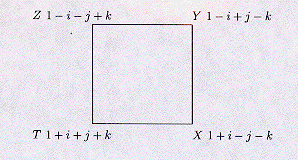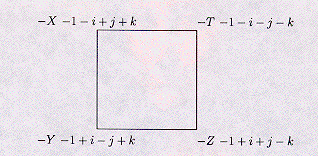

Deriving the Standard Model plus Gravitation from Simple Operations on Finite Sets by Tony Smith Table of Contents: Chapter 1 - Introduction. Chapter 2 - From Sets to Clifford Algebras. Chapter 3 - Octonions and E8 lattices. Chapter 4 - E8 spacetime and particles. Chapter 5 - HyperDiamond Lattices. Chapter 6 - Spacetime and Internal Symmetry Space. Chapter 7 - Feynman Checkerboards. Chapter 8 - Charge = Amplitude to Emit Gauge Boson. Chapter 9 - Mass = Amplitude to Change Direction. Chapter 10 - Protons, Pions, and Physical Gravitons. Appendix A - Errata for Earlier Papers. References.
According to John C. Baez and S. Jay Olson in their paper at gr-qc/0201030:
"... Ng and van Dam have argued that quantum theory and general relativity give a lower bound delta L > L^(1/3) L_P ^(2/3) on the uncertainty of any distance, where L is the distance to be measured and L_P is the Planck length. Their idea is roughly that to minimize the position uncertainty of a freely falling measuring device one must increase its mass, but if its mass becomes too large it will collapse to form a black hole. ... Amelino-Camelia has gone even further, arguing that delta L > L^(1/2) L_P ^(1/2) ... Here we show that one can go below the Ng-van Dam bound [ and the Amelino-Camelia bound ] by attaching the measuring device to a massive elastic rod. ...[ while the Ng-van Dam ] result was obtained by multiplying two independent lower bounds on delta L, one from quantum mechanics and the other from general relativity, ours arises from an interplay between competing effects. On the one hand, we wish to make the rod as heavy as possible to minimize the quantum-mechanical spreading of its center of mass. To prevent it from becoming a black hole, we must also make it very long. On the other hand, as it becomes longer, the zero-point fluctuations of its ends increase, due to the relativistic limitations on its rigidity. We achieve the best result by making the rod just a bit longer than its own Schwarzschild radius.
... Relativistic limitations on the rod's rigidity, together with the constraint that its length exceeds its Schwarzschild radius, imply that zero-point fluctuations of the rod give an uncertainty delta L > L_P . ...".
The Discrete HyperDiamond Generalized Feynman Checkerboard and Continuous Manifolds are related by Quantum Superposition:
The 4-dimensional spacetime of this HyperDiamond Feynman Checkerboard
physics model is a HyperDiamond lattice that comes from 4 dimensions of the
8-dimensional E8 lattice spacetime. If the basis of
the E8 lattice is {1, i, j, k, E, I, J, K },
then the basis of the 4-dimensional spacetime is the
associative part with basis {1, i, j, k }.
Therefore, the 4-dimensional spacetime lattice is
called the associative spacetime and denoted by 4HDa.
The 1-time and 3-space dimensions of the 4HDa spacetime
can be represented by the 4 future lightcone links and the
4 past lightcone links as in the pair of "Square Diagrams"
of the 4 lines connecting the future ends
of the 4 future lightcone links
and
of the 4 lines connecting the past ends
of the 4 past lightcone links:
The 8 links { T,X,Y,Z,-T,-X,-Y,-Z } correspond
to the 8 root vectors of the Spin(5) de Sitter gravitation
gauge group, which has an 8-element Weyl group S2^2 x S2.
The symmetry group of the 4 links of the future lightcone is S4,
the Weyl group of the 15-dimensional Conformal group SU(4) = Spin(6).
10 of the 15 dimensions make up the de Sitter Spin(5) subgroup, and
the other 5 fix the "symmetry-breaking direction" and scale of the
Higgs mechanism.
For more on this, see
WWW URL http://www.innerx.net/personal/tsmith/cnfGrHg.html
The action of Gravity on Spinors is given by
the Papapetrou Equations.
The Internal Symmetry Space of this HyperDiamond Feynman Checkerboard
physics model is a HyperDiamond lattice that comes from 4 dimensions
of the 8-dimensional E8 lattice spacetime. If the basis of
the E8 lattice is {1, i, j, k, E, I, J, K },
then the basis of the 4-dimensional Internal Symmetry Space is the
coassociative part with basis {E, I, J, K }.
Therefore, the 4-dimensional spacetime lattice is
called the associative spacetime and denoted by 4HDca.
Physically, the 4HDca Internal Symmetry Space should be thought of
as a space "inside" each vertex of the 4HDa HyperDiamond Feynman
Checkerboard spacetime, sort of like a Kaluza-Klein structure.
The 4 dimensions of the 4HDca Internal Symmetry Space are:
electric charge;
red color charge;
green color charge; and
blue color charge.
Each vertex of the 4HDca lattice has 8 nearest neighbors,
connected by lightcone links. They have the algebraic structure
of the 8-element quaternion group <2,2,2>.
Each vertex of the 4HDca lattice has 24 next-to-nearest neighbors,
connected by two lightcone links. They have the algebraic structure
of the 24-element binary tetrahedral group <3,3,2> that is
associated with the 24-cell and the D4 lattice.
As with the time as space dimensions of the 4HDa spacetime,
the E-electric and RGB-color dimensions of the 4HDca
Internal Symmetry Space can be represented by
the 4 future lightcone links and the
4 past lightcone links.
However, in the 4HDca Internal Symmetry Space the
E Electric Charge should be treated as independent of
the RGB Color Charges.
As a result the pair of "Square Diagrams"
act more like "Triangle plus Point Diagrams".
The 2+6 links { E,-E;R,G,B,-R,-G,-B } correspond to:
the 2 root vectors of the weak force SU(2),
which has a 2-element Weyl group S2; and
the 6 root vectors of the color force SU(3),
which has a 6-element Weyl group S3.
In calculations, it is sometimes convenient to use
the volumes of compact manifolds that represent spacetime,
internal symmetry space, and fermion representation space.
The compact manifold that represents 8-dim spacetime
is RP1 x S7, the Shilov boundary of the bounded complex
homogeneous domain that corresponds to Spin(10) / (Spin(8)xU(1)).
Note that S1/Z2 can be described as an orbifold.
The compact manifold that represents 4-dim spacetime is RP1 x S3, the Shilov boundary of the bounded complex homogeneous domain that corresponds to Spin(6) / (Spin(4)xU(1)). The compact manifold that represents 4-dim internal symmetry space is RP1 x S3, the Shilov boundary of the bounded complex homogeneous domain that corresponds to Spin(6) / (Spin(4)xU(1)). The compact manifold that represents the 8-dim fermion representation space is RP1 x S7, the Shilov boundary of the bounded complex homogeneous domain that corresponds to Spin(10) / (Spin(8)xU(1)). The manifolds RP1 x S3 and RP1 x S7 are homeomorphic to S1 x S3 and S1 x S7, which are untwisted trivial sphere bundles over S1. The corresponding twisted sphere bundles are the generalized Klein bottles Klein(1,3) Bottle and Klein(1,7) Bottle.
The (1,7)-dimensional RP1 x S7 = S1 x S7 = U(1) x S7 spacetime of the D4-D5-E6-E7-E8 VoDou Physics model prior to dimensional reduction can be represented by Quaternionic Projective 2-space QP2.
Atiyah and Berndt say in their paper Projective Planes, Serveri Varieties, and Spheres, math.DG/0206135, the S1 x S7 considered as QP2 breaks down into two parts:
Matti Pitkanen has suggested that the global structure of 4-dimensional Spacetime and Internal Symmetry Space should be given by 8-dimensional SU(3), which decomposes into CP2 base and U(2) fibre, both of which are 4-dimensional, by SU(3) / U(2) = CP2.
Associative 4-dimensional Spacetime, with Minkowski signature, is topologically U(2) = SU(2)xU(1) = S3 x S1 (the Euclidean signature version of Spacetime is S4),
which is consistent with the D4-D5-E6-E7-E8 VoDou Physics model Minkowski Spacetime of RP1 x S3.
Note that RP1 can be described as an orbifold.
Coassociative 4-dimensional Internal Symmetry Space is CP2.
From Sets to Quarks: Table of Contents: Chapter 1 - Introduction. Chapter 2 - From Sets to Clifford Algebras. Chapter 3 - Octonions and E8 lattices. Chapter 4 - E8 spacetime and particles. Chapter 5 - HyperDiamond Lattices. Chapter 6 - Spacetime and Internal Symmetry Space. Chapter 7 - Feynman Checkerboards. Chapter 8 - Charge = Amplitude to Emit Gauge Boson. Chapter 9 - Mass = Amplitude to Change Direction. Chapter 10 - Protons, Pions, and Physical Gravitons. Appendix A - Errata for Earlier Papers. References.
Tony Smith's Home Page ......